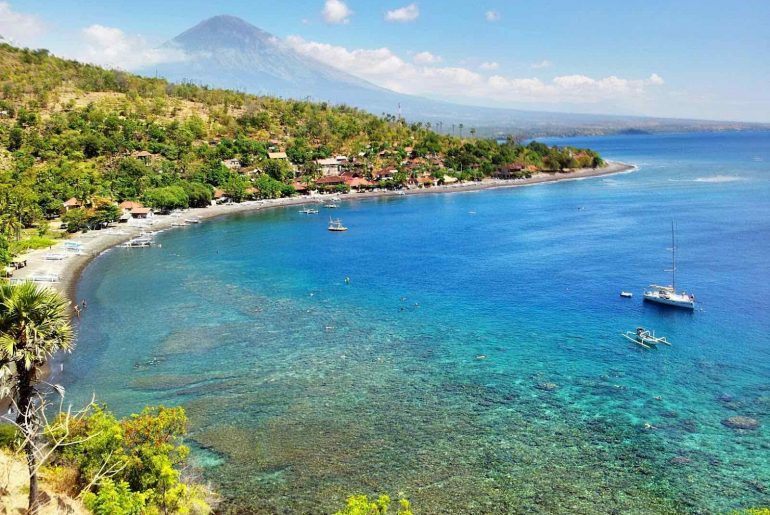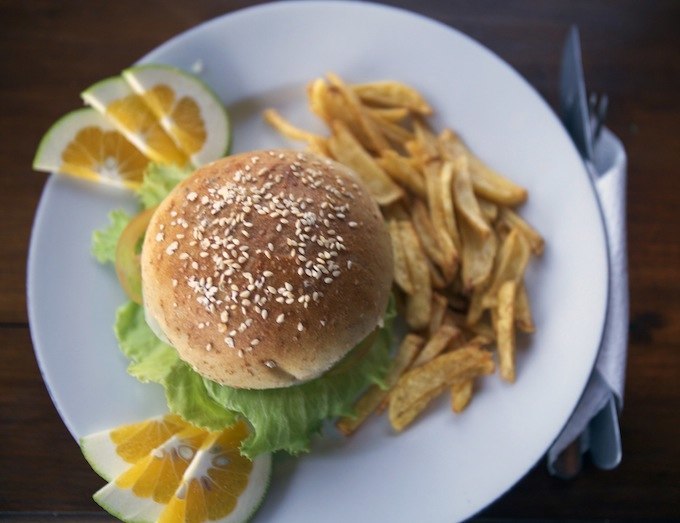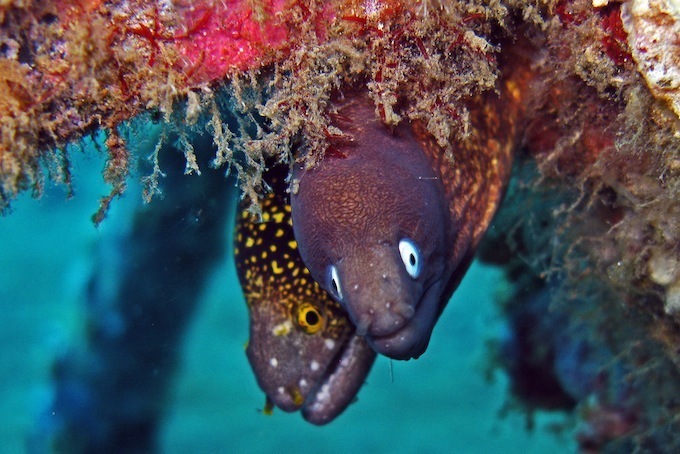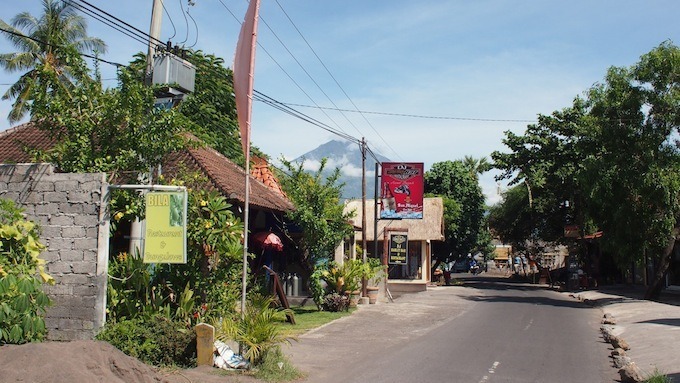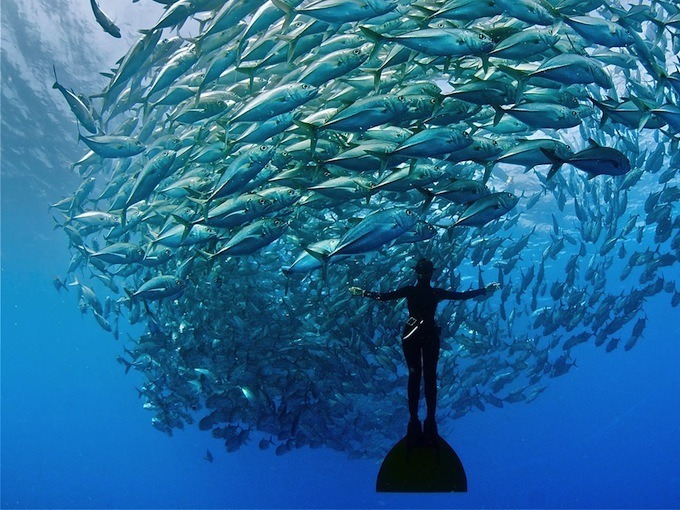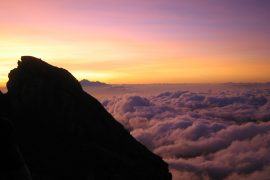For a modest fishing village that’s three hours away from Denpasar, the laid-back town of Amed has a deceptively large number of brilliant things to do. The best time to visit is on the fringes of the high season between June and August, before the homestays and cafes fill up. Besides, it’s the sort of place you want to have to yourself.
The upside of the long drive to get there from Denpasar is that prices for food, accommodation and activities drop significantly. Now you’re in the real Indonesian economy.
Rooms in a homestay cost between US$10-20 a night. You can get fed at a café for US$1-4 and the food is pretty good here. You’ll find fresh seafood, salads, spring rolls, homemade soups, burgers and pizzas on the menu. Places to eat aren’t in short supply, although people tend to gravitate to Fusion Dive school café and Hoki homestay and café for lunch and dinner.
Here are a dozen wonderful things you can get up to in Amed.
#1 Dive the Japanese shipwreck and USS Liberty
The Japanese shipwreck site in Lipah rests on a sharp slope that’s about 10 meters deep. It’s an easy dive; the small wreck is inhabited by soft and plate corals, red skeletons and fluorescent gorgonians. The larger USS Liberty wreck offers a variety of challenges for the beginner to the pro diver. The best time to explore these wrecks are in the morning.
And those are just two of many, many dive sites in Amed. At the Tulamben drop off, you’ll come face to face with reef sharks and graceful stingrays. Along the main wall, you’ll encounter a rainbow of sea life. Then off Jemeluk you’ll find the freckled eel, octopus and giant trevally.
Dives cost around US$75-85 for two dives. Check out Baruna Dive Centre (+62) 852 3838 9529 or email infobarunadivecentre@gmail.com for more info.
#2 Get your PADI
If you’ve been meaning to get your PADI, stop putting it off. Diving courses in Amed are too reasonable to pass up. The three-day open water license costs US$350. And if you want to get really serious about getting certified, a month-long Divemaster course with unlimited dives is only US$1,000. As an added bonus, you’ll find dive courses in English, French and Spanish here. What are you waiting for?
#3 Witness sunrise on top of Mount Agung
Locals believe that Mount Agung is the source of Bali’s divine spirituality and pure energy. What better way to channel Bali’s sacred spirit than by climbing to the holy summit? The most profound time to stand on top of the mountain is when the sun is rising. From the peak, you can see as far as Lombok.
The treks begin the night before at 11:45pm. By 6am you reached the top in time for the special moment (as your legs give way beneath you). The good news is that it only takes four hours to get back down to Besakih Temple, the pick up point.
Visit Bali Sunrise Tours for more information.
#4 Walk around the village
The single most endearing thing about Balinese rural life is the industrious spirit of the people. Walking around the village you’ll come across small poultry and produce farm plots and hear the banging of nails into wooden boards. With Mount Agung ever present in the backdrop, photo-ops are endless.
#5 Ride a motorcycle through the village
The best way to get to know the village is by zipping around a motorbike like the locals do. Renting a motorcycle costs only IDR50,000 a day (that’s right, a fiver). There’s plenty to see along the Amed coast that goes on for 10km before you’re officially in the next village.
#6 Go fishing in a traditional outrigger boat
Does the idea of eating what you catch whet your appetite? Barracuda, Mahi-Mahi and mackerel are abundant in these waters. A two to three hour fishing trip on a traditional outrigger boat costs about IRD150,000 and a little more during high season.
#7 Contemplate the meaning of life
The volcanic black sand beach in Amed takes a little over an hour to cross from tip to tip; the omnipresent Mount Agung standing magnificently in the distance. You can’t help but draw on the positive vibes in the air. Just the state of mind you need to make groundbreaking decisions in your life.
#8 Learn to freedive
Freediving is all about interacting with the ocean on a more intimate level. It’s also a great way to overcome your fear of the ocean (if you have one) and learn to breathe more efficiently in your daily life. The benefits of this are immense.
Fusion freediving school runs beginner, intermediate and advance courses over two to four days (IDR3,000,000 – 5,500,000), as well as specialist courses for surfers (IDR1,250,000) and specialized yoga. Visit their website to find out more about this intriguing art of diving.
Find out more on their website.
#9 Buy locally harvested salt and beaded bracelets from the local children
Admittedly, there’s only so much salt and so many bracelets one person can buy, even at $2-4 a pop. But the kids around here are really sweet and work really hard to create opportunities for themselves to get an education and contribute to their families at such a young age. Every little bit helps, so make a point to give a little love while you’re here.
#10 Take a fast boat to Gili or Lombok
The crossing between Amed and the Gilis or Lombok takes only 40 minutes, much closer than Padang Bai. Tickets are IDR250,00 each way. The Sea Express to Lombok departs at 9:30am daily. The Pacha Express makes one trip at 9am and one at 4pm, in case you want a little more time in Amed.
#11 Backtrack to Sanur by sea
If you’re heading back down to central Bali and dread the idea of the three hour drive, simply hop on the Sea Express and take a joy ride around the Gilis to end up back in Sanur.
#12 Snorkle in Jemeluk
If you’re on a shoestring budget, you don’t need to get a fishing boat out to the snorkeling reefs to have a good time. You can rent snorkelling gear for IDR30,000 and walk over to Jemeluk where you’ll see plenty of sea life just off the shore.
A parting note from Amed… this village is one of the most recent rural areas in Bali to be developed for tourism. The first tarmac roads were only laid down in 2000! Thriving tourism businesses run mostly by local families wait patiently for the recognition this magnificent ocean side spot deserves. Help them spread the word & share this article on Facebook!
